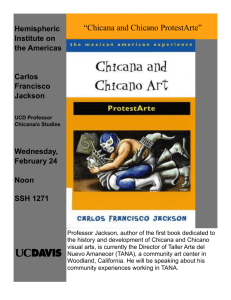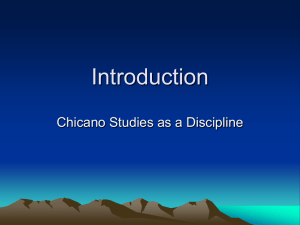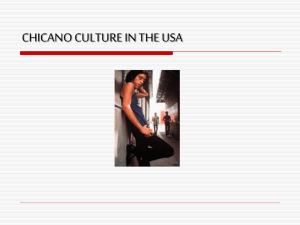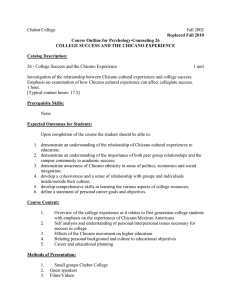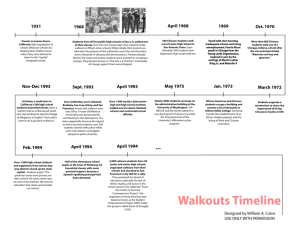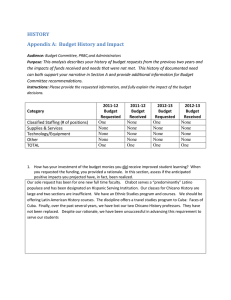2. Chican@ Literature Presentation
advertisement
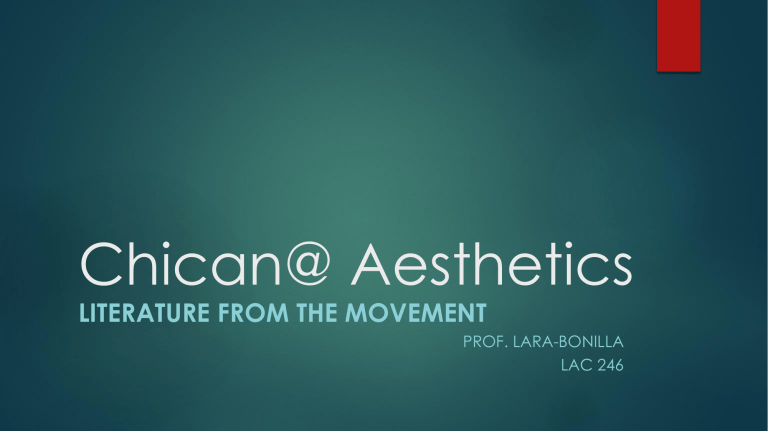
Chican@ Aesthetics LITERATURE FROM THE MOVEMENT PROF. LARA-BONILLA LAC 246 Informal Writing Prompt: Free Timed Writing “MILITANT”/ “HYBRID” (3 MIN.) “I am Joaquin” by Rodolfo “Corky” Gonzalez 1. HISTORICAL/ SOCIAL CONTEXT When “I am Joaquin” is published in 1967, the Chicano Movement is well underway. Dolores Huerta and Cesar Chavez had founded the United Farm Workers Union in 1962. Luis Valdez had founded Teatro Campesino in1965. Chicanas/os were attending college in greater numbers. Literature is used to inspire social and political action. THE AUTHOR: BIOGRAPHICAL INFO Rodolfo “Corky” Gonzalez (1928-2005) was one of the most salient leaders of the Chicano Movement. After being disillusioned by mainstream politics, he organized workers and students as a more radical activist. Created the Crusade for Justice, a service-oriented cultural center. Self-published I am Joaquin in 1967. Convened the First Annual Chicano Youth Conference in 1969. Created the Colorado Chapter of La Raza Unida Party in 1972 . THE TEXT ITSELF: “I am Joaquin” The poem provided a nationalist aesthetic and served as a model for later Chicano/a poets. It made audiences remember history, including the 19th century figure of Joaquín Murrieta, an outlaw and social rebel who fought against Anglo settler colonialism. The poem had a great impact and influence in the Chicano movement, especially among youth, at a period of euphoria. (AUDIO)VISUAL INFORMATION “I AM JOAQUIN”: A reading and recording by Luis Valdez from 1969. http://wn.com/i_am_joaquin QUESTION TO THE CLASS What do you find unique about this reading or about this poem? TRIPLE JOURNAL ENTRY Quote Relevance My/Our thoughts “I am the Maya Prince. These lines are alluding to three different lines of ethnic ancestry and civilizations: Maya, Aztec, and European (Spanish). They synthesize the central idea of hybridity, so relevant in the poem. I find interesting that this and other Latina/o poems from the “movement era” insist on cultural nationalism and ethnic identity while describing mixed racial backgrounds and cultural heritages. I can relate to that because I feel we are never just “one thing.” I am Nezahualcoyotl, great leader of the [Chichimecas I am the sword and [flame of Cortes The despot.” (197) Teatro Campesino- Luis Valdez (founded,1965) Valdez worked with the newly created United Farm Worker’s Union, founded by Cesar Chavez and Dolores Huerta. He organized the workers to form a grassroots improvisational theater movement through which they could dramatize their issues and struggle. Composed mostly of students and workers, El Teatro toured the nation and eventually became professionalized. -They ended up publishing their works in Actos the theatre magazine in order to give stability to the movement. -As Kanellos states, they “[e]ventually, a generation grew of not only theaters and actors, but also of bilingual-bicultural playwrights, directors, producers, and theater educators” (13). Teatro Campesino- Luis Valdez (1940-) Key tenets of Teatro Campesino: Chicano theater must be produced “for the Chicano nation” and address Chicana/o issues. The “Chicano nation” is understood in geographic, religious, cultural, and racial roots in Atzlán, the ancestral land of Chicanos/as. Bicultural and bilingual (or sometimes only Spanish-speaking), with a rural orientation and, as other literary works in the movement, with a strong emphasis on pre-Columbian heritage. Teatros must be close to “La Raza.” Chicano theater must be produced by Chicnos/as. It must support itself (no external grants or other kind of help). Some Visual Resources This video introduces the work of Luis Valdez since the late 1960s until 2009: https://www.youtube.com/watch?v=isPFm9A_xRM Why can he be consider an important figure in the history of Laitinx and U.S. literature and culture? This video of a performance of Los Vendidos illustrates the cultural and historical identities depicted in the play: https://www.youtube.com/watch?v=kTIng1n71_s What relevant information do you obtain from seeing this performance that you could not access by simply reading the play? Why is it relevant? Los Vendidos by Luis Valdez (1967) WRITING/DISCUSSION QUESTIONS: -What are the main features of each stereotype? -What is the ‘story’ in this play? What is the main plot question? Considering how the action unfolds, can you identify key “moments of engagement” in the play? In one sentence (or two), what happens at the end of the play? What answer does it provide to the main plot question? What comment does it make to at least one of the main themes of the play? Chicano literary aesthetics: In the “Overview,” Kanellos provides key elements of the Chicano literary movement (13): -Working-class aesthetics, Community poets and activists raised in the oral tradition (recitation, declamation) Beginning of movement in mid-1960s with the founding of the United Farm Workers Union by César Chávez and Dolores Huerta. Hispanics attend college in greater numbers (Johnson/Kennedy laws) Chicano literature questions commonly accepted version of history and equality. Literature is used to inspire social and political action (at meetings, protests, boycotts, etc.) Key literary texts and figures Kanellos identifies two key literary figures which are key in the history of the Chicano movement (13): 1965 El Teatro Campesino is founded by playwright and activist Luis Valdez. 1967 The epic “I am Joaquín” is written and self-published by Rodolfo “Corky” Gonzales, who also founded the organization Crusade for Justice. In Chapter 7, Kanellos also includes two Chicana authors who are key in developing the Chicana feminist movement and U.S. Third Wave Feminism: Cherrie Moraga Gloria Anzaldua Chicana literary and feminism, 1980s Widespread versions of Chicano cultural nationalism did not include women as heroines, or identities “belonging” to the Chicano nation. The Chicana perspective, but also the queer/gay/lesbian perspective was quite absent -when not overtly excluded or relegated to the background- from the Chicano Movement. Chicana feminists Gloria E. Anzaldúa and Cherríe Moraga brought to the fore, offer a critique, a revision of Chicano cultural nationalism. Anzaldúa and Moraga are key in the creation of a Chicana feminist movement and the Third Wave/ Women of Color feminist movement in the U.S. Cherrie Moraga (1952- ) Chicana writer, feminist activist, poet, essayist, and playwright. Abbreviated list of works: • A Xicana Codex of Changing Consciousness: Writings 2000-2010 (2011). Durham: Duke University Press. • Watsonville: Some Place Not Here; Circle in the dirt: el pueblo de East Palo Alto (2002). Albuquerque: West End Press. • The Hungry Woman (2001). Albuquerque: West End Press. • Waiting in the Wings: Portrait of a Queer Motherhood (1997) Ithaca: Firebrand Books. • Heroes and Saints and Other Plays (1994). Albuquerque: West End Press. • The Last Generation: Prose and Poetry The (1993). Boston: South End Press. • The Sexuality of Latinas (co-editor, 1993). Berkeley: Third Woman Press. • Shadow of a Man (1992) • Giving Up the Ghost: Teatro in Two Acts (1986). Los Angeles: West End Press. • Cuentos: Stories By Latinas (co-editor, 1983). New York: Kitchen Table: Women of Color Press. • Loving in the War Years: Lo que nunca pasó por sus labios (1983). Boston: South End Press. • This Bridge Called My Back: Writings by Radical Women of Color (co-editor, with Gloria E. Anzaldua). Watertown, Massachusetts: Persephone Press, 1981. Gloria Anzaldua (1942-2004) Scholar of Chicana cultural theory, feminist theory, and queer theory. Transformed autobiography/ autoethnography for Latin@ writers and inspired the creation of the“Border Studies” field. Selected works: • This Bridge Called My Back: Writings by Radical Women of Color (1981), New edition: Third Women Press, 2001. • Borderlands/La Frontera: The New Mestiza (1987), Aunt Lute Books. • Making Face, Making Soul/Haciendo Caras: Creative and Critical Perspectives by Feminists of Color, Aunt Lute Books (1990). • Interviews/Entrevistas (2000). • This Bridge We Call Home: Radical Visions for Transformation (2002). • The Gloria Anzaldúa Reader, edited by AnaLouise Keating. Duke University Press (2009). Children's books • Prietita Has a Friend (1991) • Friends from the Other Side/Amigos del Otro Lado (1995) • Prietita y La Llorona (1996) Audiovisual Resources: CHICANO MOVEMENT: PBS Latino Americans Chapter 3. “I AM JOAQUIN”: http://wn.com/i_am_joaquin; http://latinopia.com/latino-history/rodolfocorkygonzalez/ LOS VENDIDOS: http://hidvl.nyu.edu/video/000539678.html CHERRIE MORAGA: http://www.makers.com/moments/defending-who-i-was (2 videos) GLORIA ANZALDUA: http://voca.arizona.edu/index.php?reading_id=687
